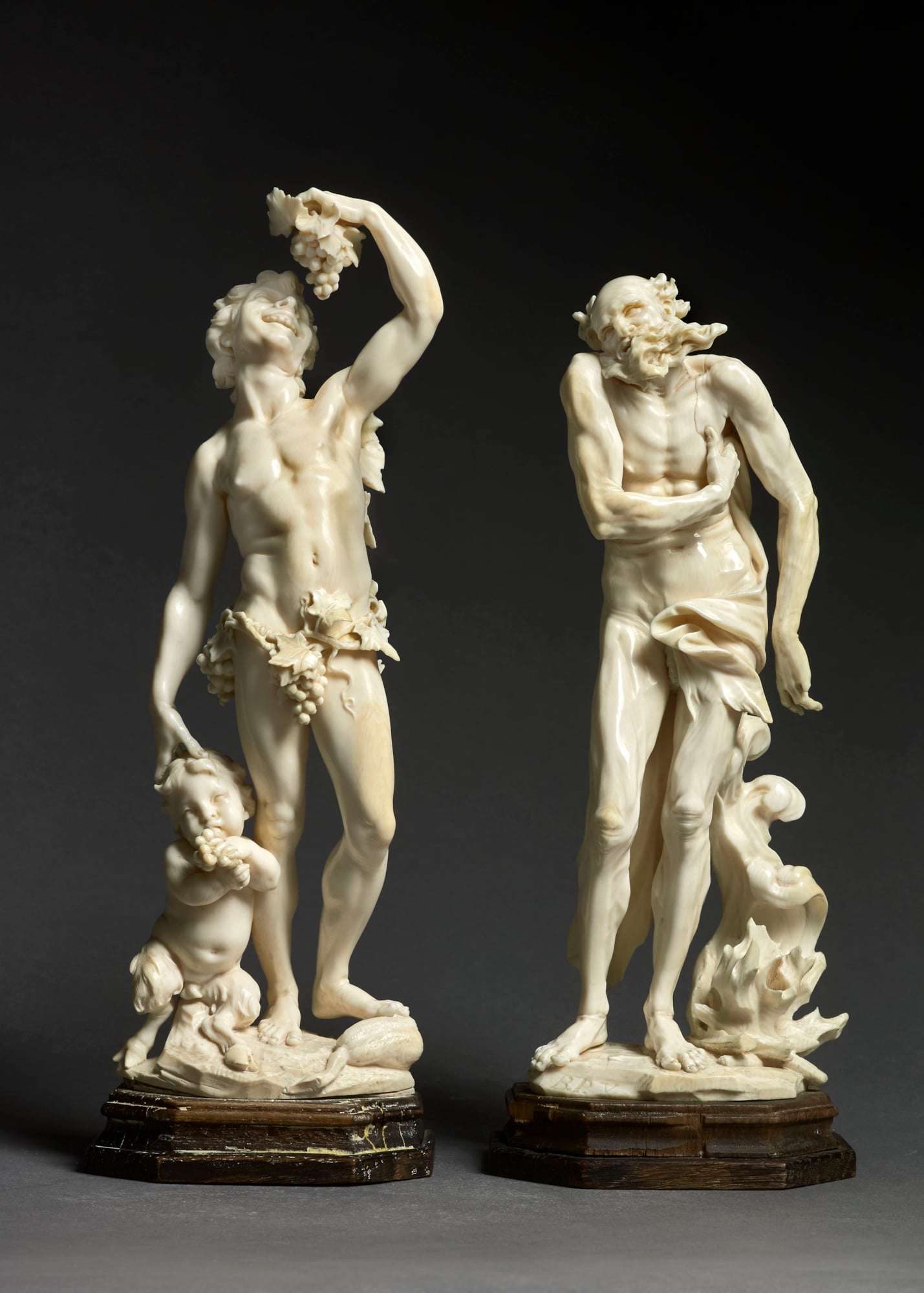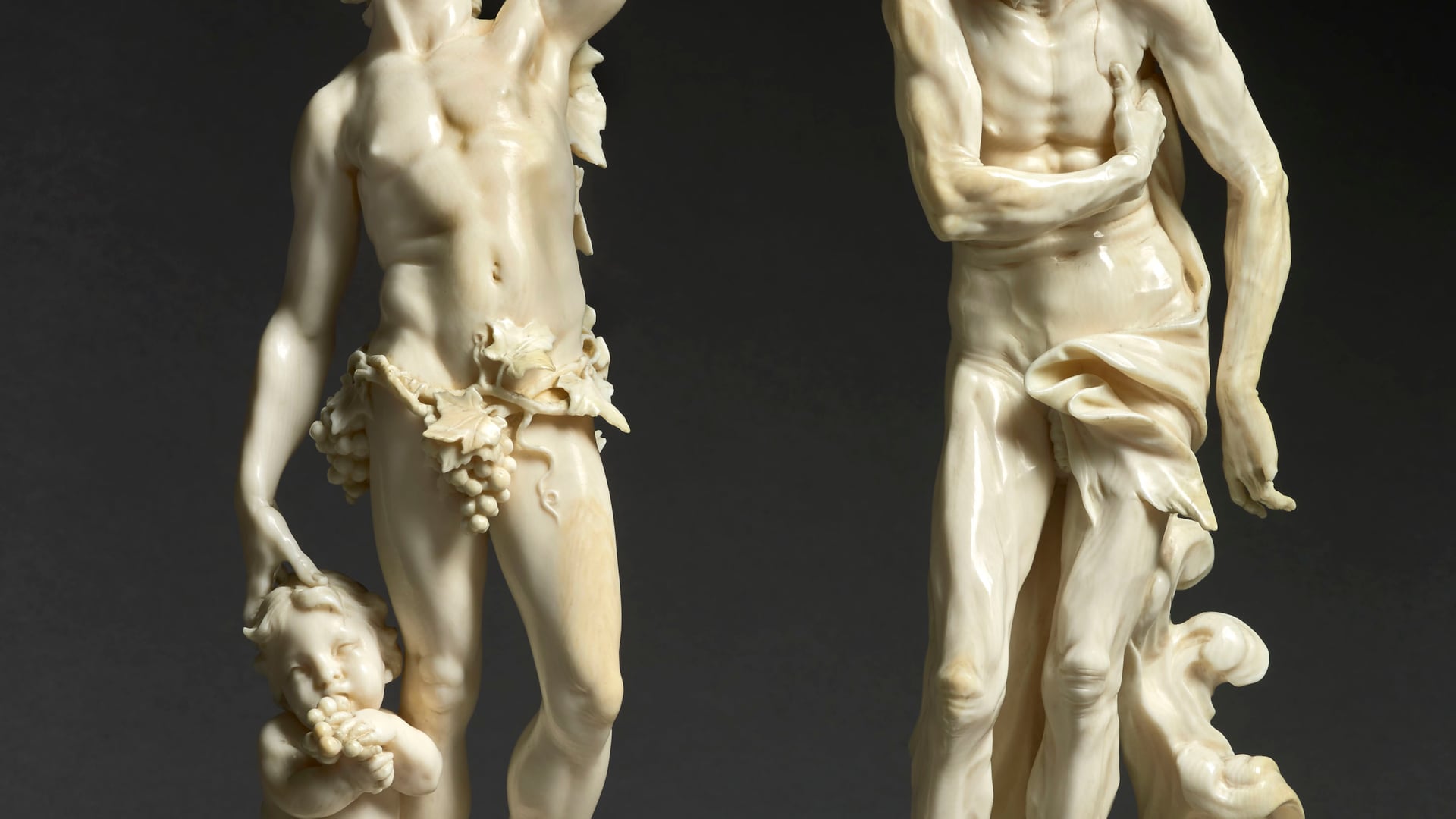

Provenance:
first documented as belonging to the Duke of Braunschweig, on the occasion of the transport from the castle of Salzdahlum to Braunschweig, 9 October 1722
in the inventory H 32 of the Kunst und Naturalienkabinett, Braunschweig, 1798
confiscated by Dominique Vivant Denon on the order of Napoleon in 1806 (not present among the works of art restituted to Braunschweig in 1815)
probably acquired in Paris by Edward Viscount Lascelles (1767-1814)
brought by him to Harewood House, Leeds
Harewood Trust, Leeds, inv. nn. HHTS 2001.1.33 and HHTS 2001.1.17.
Daniel Kat Gallery, 2016, by whom sold to the Herzog Anton Ulrich-Museum, Braunschweig, Germany.
first documented as belonging to the Duke of Braunschweig, on the occasion of the transport from the castle of Salzdahlum to Braunschweig, 9 October 1722
in the inventory H 32 of the Kunst und Naturalienkabinett, Braunschweig, 1798
confiscated by Dominique Vivant Denon on the order of Napoleon in 1806 (not present among the works of art restituted to Braunschweig in 1815)
probably acquired in Paris by Edward Viscount Lascelles (1767-1814)
brought by him to Harewood House, Leeds
Harewood Trust, Leeds, inv. nn. HHTS 2001.1.33 and HHTS 2001.1.17.
Daniel Kat Gallery, 2016, by whom sold to the Herzog Anton Ulrich-Museum, Braunschweig, Germany.
Exhibited:
Barockplastik in Norddeutschland, Hamburg, 1977
The Treasure Houses of Great Britain, National Gallery of Washington, 1985
“Diaphanous Passions” Baroque Ivories from the Courts of Europe, Pitti Palace, Florence, 2013
Barockplastik in Norddeutschland, Hamburg, 1977
The Treasure Houses of Great Britain, National Gallery of Washington, 1985
“Diaphanous Passions” Baroque Ivories from the Courts of Europe, Pitti Palace, Florence, 2013
Literature:
Ch. Scherer, Studien zur Elfenbeinplastik, Strasburg,1897, pp. 34-40
Ch. Scherer, Studien zur Elfenbeinplastik seit der Renaissance, Leipzig, 1903, pp. 85-86
H. Beschorner, Permoser-Studien, Dresden, 1913, p. 126
O. Pelka, Elfenbein, Berlin, 1920, pp. 261-263
E. Michalski, Balthasar Permoser, Frankfurt, 1927, pp. pp. 10, 26
Ch. Scherer, Die Braunschweiger Elfenbeinsammlung, Katalog der Elfenbeinbilderwork des Herzog Anton Ulrich-Museums in Braunschweig, Leipzig, 1931, pp. 52-53, n. 78-79
Thieme-Becker, Allgemeines Lexicon der bildenden Künster, Leipzig, XXVI, 1932
W. Boeck, Balthasar Permoser – der Bildhauer des deutschen Barocks, Burg, 1938, pp. 13, 18
E. Von Philippovich, “Elfenbein und Porzellan” in Kermaik-Freunde der Schweiz, 47 1959, p. 24
E. Von Philippovich, Elfenbein. Ein handbuch für Sammler und Liebhaber, Braunschweig, 1961, pp. 180, 186
Deutsche Kunst des Barock, exh. cat., Braunschweig, 1975, pp. 77-78, n. 136-137
Barockplastik in Norddeutschland, exh. cat., Hamburg, 1977, pp. 491-495, n. 185-188
S. Asche, Balthasar Permoser. Leben und Werk, Berlin, 1978, pp. 42-44
The Treasure Houses of Great Britain, 500 years of Private Patronage of Art Collecting, Washington, 1985, National Gallery of Washington/Yale
Herzog Anton Ulrich von Braunschweig – Leben und Regieren mit der Kunst, exh. cat. Braunschweig, 1983, pp. 175-176, n. D13-D14
Herzog Anton Ulrich zu Gast in Dresden. Schatzkammerstücke des Herzog Anton Ulrich-Museums Braunschweig, exh. cat., Dresden, 2012 pp. 41-46
Diafane Passioni. Avori barocchi dale corti europee, Florence, 2013, pp. 326-329, n. 127 and 128
Ch. Scherer, Studien zur Elfenbeinplastik, Strasburg,1897, pp. 34-40
Ch. Scherer, Studien zur Elfenbeinplastik seit der Renaissance, Leipzig, 1903, pp. 85-86
H. Beschorner, Permoser-Studien, Dresden, 1913, p. 126
O. Pelka, Elfenbein, Berlin, 1920, pp. 261-263
E. Michalski, Balthasar Permoser, Frankfurt, 1927, pp. pp. 10, 26
Ch. Scherer, Die Braunschweiger Elfenbeinsammlung, Katalog der Elfenbeinbilderwork des Herzog Anton Ulrich-Museums in Braunschweig, Leipzig, 1931, pp. 52-53, n. 78-79
Thieme-Becker, Allgemeines Lexicon der bildenden Künster, Leipzig, XXVI, 1932
W. Boeck, Balthasar Permoser – der Bildhauer des deutschen Barocks, Burg, 1938, pp. 13, 18
E. Von Philippovich, “Elfenbein und Porzellan” in Kermaik-Freunde der Schweiz, 47 1959, p. 24
E. Von Philippovich, Elfenbein. Ein handbuch für Sammler und Liebhaber, Braunschweig, 1961, pp. 180, 186
Deutsche Kunst des Barock, exh. cat., Braunschweig, 1975, pp. 77-78, n. 136-137
Barockplastik in Norddeutschland, exh. cat., Hamburg, 1977, pp. 491-495, n. 185-188
S. Asche, Balthasar Permoser. Leben und Werk, Berlin, 1978, pp. 42-44
The Treasure Houses of Great Britain, 500 years of Private Patronage of Art Collecting, Washington, 1985, National Gallery of Washington/Yale
Herzog Anton Ulrich von Braunschweig – Leben und Regieren mit der Kunst, exh. cat. Braunschweig, 1983, pp. 175-176, n. D13-D14
Herzog Anton Ulrich zu Gast in Dresden. Schatzkammerstücke des Herzog Anton Ulrich-Museums Braunschweig, exh. cat., Dresden, 2012 pp. 41-46
Diafane Passioni. Avori barocchi dale corti europee, Florence, 2013, pp. 326-329, n. 127 and 128
After having lived in Rome and worked for the Medici in Florence, Balthasar Permoser accepted an invitation to the court of the Elector of Saxony and moved to Dresden in 1690. Remaining in that city until his death (except for a period in Berlin), he produced a range of works, from monumental sculptures to devotional pieces full of pathos and exquisite ivory figures.
Permoser’s series of the four seasons in ivory, signed and dated 1695, was executed in Dresden. The figures of Spring, Summer, Autumn and Winter were split into two pairs in the early 19th century while in Paris and only the female figures were returned to Braunschweig (now Herzog Anton Ulrich Museum). After almost two centuries of separation the four ivories were temporarily reunited on the occasion of the exhibition held in Florence in 2013 (see lit.). The elegant movement that animates the figures and the technical virtuosity in the carving make them masterpieces of the late Baroque period.
Following the Renaissance tradition of representing Roman gods as personifications of the four seasons, Permoser carved a smiling figure of Flora (Spring), an energetic Ceres (Summer), a drunken Bacchus (Autumn) and an aged Vulcan (Winter). Permoser illustrated the theme more than once, not only in ivory but also on a monumental scale, as with the Ceres and Vulcan in stone at the Zwinger, Dresden (1714/1715)[1]. It is known that the artist carved two other ivory groups of the same subject: one, undated, is in in the Grünes Gewölbe, Dresden, the other, now lost, was formerly in the collection of Carlo Ginori in Florence and was used as model in his porcelain factory at Doccia from the mid-18th century. Extant Doccia porcelain statuettes indicate that the Ginori group was presenting some comparable compositional elements with our ivories and those in Braunschweig. The Dresden cycle however is entirely different and very likely of a later date, ca. 1714. The present ivories, along with their female counterparts in Braunschweig, are thought to be Permoser’s first treatment of the subject[2]. That they are the artist’s original invention is supported by his inclusion of the word ‘invenit’ in his signature on the figures of Spring, Summer and Autumn. They are a tour de force in ivory carving, with subtle rendering of textures and virtuoso detailing. Their composition is lively and the naturalism of the poses remarkable. The statuettes are in exceptional condition.
Carved in 1695, the statuettes very likely entered the Braunschweig collection at the time of Anton Ulrich, Duke of Braunschweig (reg 1685–1714), one of the most outstanding German Baroque princes. Anton Ulrich’s most important building enterprise was Schloss Salzdahlum (destroyed in 1812). Work began in 1688 and after 1700 the orangery and more wings to house the art collections were added; the Grosse Galerie was the first independent gallery built for the express purpose of housing paintings and sculptures in Germany. In his own lifetime the Duke’s collections were widely known, attracting many visitors. They included many important works by Italian, Netherlandish, and Dutch masters, in particular Rembrandt and his circle, as well as sculptures and Italian majolica that are now in the Herzog Anton Ulrich-Museum in Braunschweig. Anton Ulrich’s son, Augustus William, Duke of Braunschweig (reg 1714–31), sought to emulate the brilliance of his father’s household. From 1718 he had a palace constructed in Braunschweig by the architect Hermann Korb, where the present ivories were brought to in 1722 from the palace of Salzdahlum.
Charles I, Duke of Braunschweig (reg 1735–80), opened the family art collection to the public. When Napoleon expanded his hegemony into Germany, he seized art from the conquered territories, the newly director of the Louvre museum Dominique Vivant Denon carefully selecting the most outstanding pieces. It was then that the ivory cycle of the Four Seasons was taken to France. Part of the loot was restituted to Braunschweig in 1815, including the figures of Spring and Summer, however the present ivories remained in Paris where they was acquired by Edward Viscount Lascelles sometimes before 1814 and then brought to Leeds.
[1] for illustrations see S. Asche, 1978, pp. 232-235
[2] see J. L. Burk’s entry in the exh. cat. Diafane Passioni, 2013, p. 328